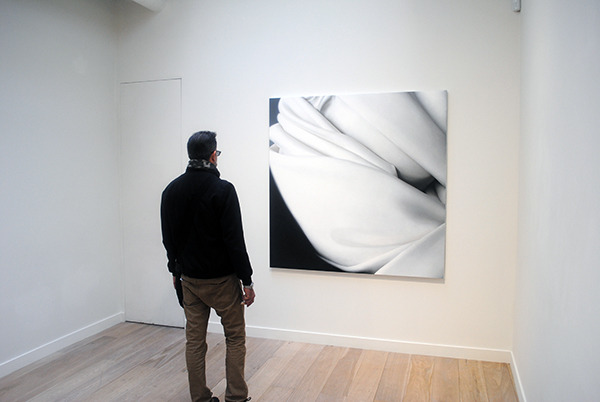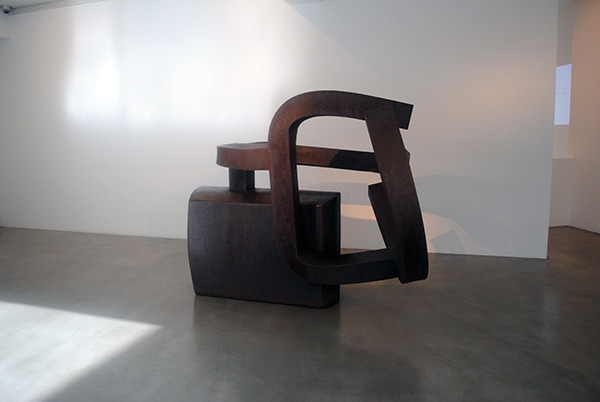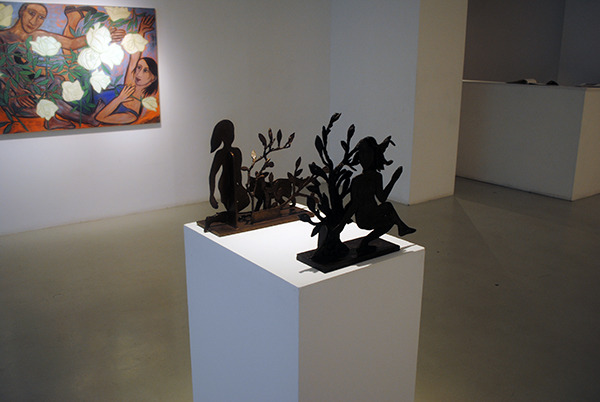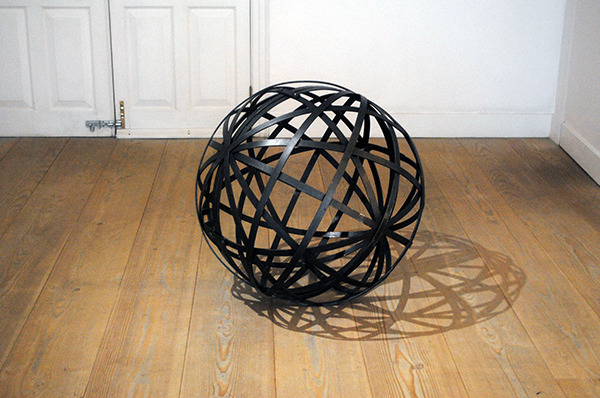Wang Guangle: Yellow – Pace Gallery London – until 16 Apr 2016
 Image: Wang Guangle, Yellow, installation view, Pace Gallery London. Photo: P A Black © 2016.
Image: Wang Guangle, Yellow, installation view, Pace Gallery London. Photo: P A Black © 2016.
Pace Gallery London is currently displaying ‘Yellow’, the first solo exhibition of work by Chinese artist Wang Guangle in Europe. The artist’s practice is an attempt to address temporality in art. The work becomes a signifier of process and labour, art as markers throughout the passage of time and Wang’s life. The abstract painter’s particular focus on the colour yellow is a cultural expression, a relationship to the Chinese connotation of the erotic, or in the eyes of the western viewer, one of cowardice or timidity. Wang uses this colour as an emotional signifier within the works – as with the artist’s evocative ‘Coffin Paintings’ employing the very physical process of layering paint; a reference to the artist’s home province, Fujian, where elderly men add a fresh layer of lacquer to their coffins in anticipation of their death, once a year. An obsession with temporality and mortality lies just beneath the surface of Wang’s yellow abstractions.
Alison Watt: The Sun Never Knew How Wonderful It Was – Parafin Gallery – until 7 May 2016
 Image: Alison Watt, The Sun Never Knew How Wonderful It Was, installation view, Parafin Gallery. Photo P A Black © 2016.
Image: Alison Watt, The Sun Never Knew How Wonderful It Was, installation view, Parafin Gallery. Photo P A Black © 2016.
Parafin Gallery is presenting an exhibition of new work by Scottish painter Alison Watt, which is the artist’s first exhibition in London since 2008 and her solo show at the National Gallery. Watt’s practice begins with a focus on a work by Peter Paul Rubens, titled ‘Venus Frigida’ (1614), found in the collection of the Royal Museum of Fine Arts in Antwerp. The artist explores Rubens’ study of Venus and his inspiration, a marble statue in Rome. The resulting painting vibrates between two states of being: at once with a cold and lifeless solidity, and rolling into the voluptuousness of the Rubenesque. Watt explores the nature of material and flesh in close-up, resulting in fusion of abstract and meditative minimalism with aspects of painterly figuration.
Chillida: Rhythm-Time-Silence – Ordovas Gallery – until 23 April 2016
 Image: Eduardo Chillida, Elogio Del Vacio VI, 2000. Rhythm-Time-Silence, Ordovas Gallery. Photo P A Black © 2016.
Image: Eduardo Chillida, Elogio Del Vacio VI, 2000. Rhythm-Time-Silence, Ordovas Gallery. Photo P A Black © 2016.
Ordovas Gallery Savile Row, is currently displaying works by the late Eduardo Chillida. Chillida: Rhythm-Time-Silence follows the exhibition’s recent display to inaugurate the gallery’s presence in the United States, which was the first exhibition to be dedicated to the work of Chillida in New York in twenty-six years. The artist has gained recent attention; having been relatively forgotten since Chillida’s Guggenheim exhibition in 1980, and represents a now familiar European Post-war sculpture; with works investigating form, space, and material usage in sculptural practice, site-specific, weighty objects reflecting architecture and nature, here seemingly taken a little out of context. The pieces are monumental and imposing works of granite and corten steel, commanding their space. A show for anyone studying the evolution of European sculpture may find this largely forgotten artist of note.
Sterling Ruby: WORK WEAR – Sprueth Magers – until 9 April 2016
 Image: Sterling Ruby: WORK WEAR: Garment And Textile Archive 2008 – 2016, installation view, Sprueth Magers London. Photo P A Black © 2016.
Image: Sterling Ruby: WORK WEAR: Garment And Textile Archive 2008 – 2016, installation view, Sprueth Magers London. Photo P A Black © 2016.
This is the last chance to see Sterling Ruby’s curious exhibition WORK WEAR at Sprueth Magers. It would seem that context is absolutely everything for the artist: as Ruby juxtaposes creative practice with the utilitarian, juggling with their hierarchical positions. The artist collects scraps from her practice of soft sculpture and collage and creates garments of heavy weight denim and canvas to be worn as “studio camouflage”, recontextualising her own work, as a ritualistic conclusion of other projects. This highlights the Bauhaus dichotomy: craft and design versus high art, blurring these boundaries and that of Ruby’s identity with the artwork, and the nature of physicality in terms of an artist’s practice. The body is ever present, even in its absence. With Ruby’s practice it is decidedly present.
Eileen Cooper RA: Love-In-Idleness – Rook & Raven – until 28 May 2016
 Image: Eileen Cooper RA: Love-In-Idleness, installation view, Rook & Raven. Photo P A Black © 2016.
Image: Eileen Cooper RA: Love-In-Idleness, installation view, Rook & Raven. Photo P A Black © 2016.
Rook & Raven is presenting a new body of work by Eileen Cooper RA, with the exhibition Love-in-Idleness, a title taken from a speech by Oberon in Shakespeare’s ‘A Midsummer Night’s Dream’. An apt choice for the artist expressionistic and lyrical practice, and Cooper’s subject matter of the passions of life. The artist brings with it her own subjective female perspective, simultaneously infusing her canvases with bold expressiveness and yet subtlety. Cooper also presents a recent departure from her usual practice in the form of a new group of works in bronze, transposing her primitive and naive figuration into three-dimensions, with the artist’s characteristic boldness. Cooper mixes drawing and painting creating expressive figuration and instinctual mark-making, resulting in a vibrant and reflective oeuvre exploring time and spirit.
Kalliopi Lemos: In Balance – Gazelli Art House – until 30 April 2016
 Image: Kalliopi Lemos, Sphere from ‘At the Centre of the World’, 2015, Gazelli Art House. Photo P A Black © 2016.
Image: Kalliopi Lemos, Sphere from ‘At the Centre of the World’, 2015, Gazelli Art House. Photo P A Black © 2016.
Upon entering Gazelli Art House the viewer is drawn to what appears to be a video installation of a ubiquitous 70’s performance piece. No one is being shot, or hiding under the gallery floor performing questionable physical acts, but a woman does roll around inside a metal sphere, caged and struggling. One would instantly conclude that this was a Vito Acconci performative action that had somehow been lost to the passage of time, and had become embarrassingly absent from the viewer’s critical education. But it is in fact a work by the Greek-born, London-based sculptor, painter and installation artist Kalliopi Lemos. The exhibition ‘In Balance’; explores freedom through physical and psychological space, the highlight of which is the aforementioned ‘retro’ video, ‘At the Centre of the World’, 2015, which was the winner of the Borusan Contemporary Art Collection Prize. The external physical struggle to escape from the cage-like iron globe becomes an internal struggle for acceptance, all very existential and Acconci-esque.
Words: Paul Black
Lead image: Kalliopi Lemos, ‘At the Centre of the World’, 2015, Gazelli Art House. Photo P A Black © 2016.
